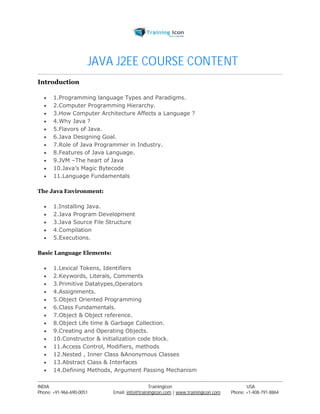
JAVA J2 EE ONLINE TRAINING
- 1. JAVA J2EE COURSE CONTENT Introduction 1.Programming language Types and Paradigms. 2.Computer Programming Hierarchy. 3.How Computer Architecture Affects a Language ? 4.Why Java ? 5.Flavors of Java. 6.Java Designing Goal. 7.Role of Java Programmer in Industry. 8.Features of Java Language. 9.JVM –The heart of Java 10.Java’s Magic Bytecode 11.Language Fundamentals The Java Environment: 1.Installing Java. 2.Java Program Development 3.Java Source File Structure 4.Compilation 5.Executions. Basic Language Elements: 1.Lexical Tokens, Identifiers 2.Keywords, Literals, Comments 3.Primitive Datatypes,Operators 4.Assignments. 5.Object Oriented Programming 6.Class Fundamentals. 7.Object & Object reference. 8.Object Life time & Garbage Collection. 9.Creating and Operating Objects. 10.Constructor & initialization code block. 11.Access Control, Modifiers, methods 12.Nested , Inner Class &Anonymous Classes 13.Abstract Class & Interfaces 14.Defining Methods, Argument Passing Mechanism ----------------------------------------------------------------------------------------------------------------------------------------------------------------------------------------------- INDIA Trainingicon USA Phone: +91-966-690-0051 Email: info@trainingicon.com | www.trainingicon.com Phone: +1-408-791-8864
- 2. 15.Method Overloading, Recursion. 16.Dealing with Static Members. Finalize() Method. 17.Native Method. Use of “this “ reference. 18.Use of Modifiers with Classes & Methods. 19.Design of Accessors and Mutator Methods 20.Cloning Objects, shallow and deep cloning 21.Generic Class Types 22.Syllabus 23. Extending Classes and Inheritance 24.Use and Benefits of Inheritance in OOP 25.Types of Inheritance in Java 26.Inheriting Data Members and Methods 27.Role of Constructors in inheritance 28.Overriding Super Class Methods. 29.Use of “super”. 30.Polymorphism in inheritance. 31.Type Compatibility and Conversion 32.Implementing interfaces. 33.Package 34.Organizing Classes and Interfaces in Packages. 35.Package as Access Protection 36.Defining Package. 37.CLASSPATH Setting for Packages. 38.Making JAR Files for Library Packages 39.Import and Static Import 40.Naming Convention For Packages Exception Handling: 1.The Idea behind Exception 2.Exceptions & Errors 3.Types of Exception 4.Control Flow In Exceptions 5.JVM reaction to Exceptions 6.Use of try, catch, finally, throw, throws in Exception Handling. 7.In-built and User Defined Exceptions 8.Checked and Un-Checked Exceptions Arrays & Strings : 1.Defining an Array ----------------------------------------------------------------------------------------------------------------------------------------------------------------------------------------------- INDIA Trainingicon USA Phone: +91-966-690-0051 Email: info@trainingicon.com | www.trainingicon.com Phone: +1-408-791-8864
- 3. 2.Initializing & Accessing Array 3.Multi –Dimensional Array 4.Operation on String 5.Mutable & Immutable String 6.Using Collection BasesLoopfor String 7.Tokenizing a String 8.Creating Strings using StringBuffer Threads: 1.Understanding Threads 2.Needs of Multi-Threaded Programming. 3.Thread Life-Cycle 4.Thread Priorities 5.Synchronizing Threads 6.Inter Communication of Threads 7.Critical Factor in Thread -DeadLock 8. Applet 9.Applet & Application 10.Applet Architecture. 11.Parameters to Applet 12.Embedding Applets in Web page. 13.Applet Security Policies 14.A Collection of Useful Classes 15.Utility Methods for Arrays 16.Observable and Observer Objects 17.Date & Times 18.Using Scanner 19.Regular Expression 20.Input/Output Operation in Java(java.io Package) 21.Streams and the new I/O Capabilities 22.Understanding Streams 23.The Classes for Input and Output 24.The Standard Streams 25.Working with File Object 26.File I/O Basics 27.Readingand Writing to Files 28.Buffer and Buffer Management 29.Read/Write Operations with File Channel 30.Serializing Objects 31.GUI Programming ----------------------------------------------------------------------------------------------------------------------------------------------------------------------------------------------- INDIA Trainingicon USA Phone: +91-966-690-0051 Email: info@trainingicon.com | www.trainingicon.com Phone: +1-408-791-8864
- 4. 32.Designing Graphical User Interfaces in Java 33.Components and Containers 34.Basics of Components 35.Using Containers 36.Layout Managers 37.AWT Componets 38.Adding a Menu to Window 39.Extending GUI Features Using Swing Components 40.Java Utilities (java.util Package) The Collection Framework : 1.Collections of Objects 2.Collection Types 3.Sets 4.Sequence 5.Map 6.Understanding Hashing 7.Use of ArrayList & Vector 8. Event Handling 9.Event-Driven Programming in Java 10.Event- Handling Process 11.Event-Handling Mechanism 12.The Delegation Model of Event Handling 13.Event Classes 14.Event Sources 15.Event Listeners 16.Adapter Classes as Helper Classes in Event Handling 17.Anonymous Inner classes a Short –cut to Event Handling 18.Avoiding Deadlocks in GUI Code 19.Event Types & Classes 20.Networking Programming 21.Networking Basics 22.Client-Server Architecture 23.Socket Overview 24.Networking Classes and Interfaces 25.Network Protocols 26.Developing Networking Applications in Java 27.DataBase Programming using JDBC 28.Introduction to JDBC 29.JDBC Drivers & Architecture ----------------------------------------------------------------------------------------------------------------------------------------------------------------------------------------------- INDIA Trainingicon USA Phone: +91-966-690-0051 Email: info@trainingicon.com | www.trainingicon.com Phone: +1-408-791-8864
- 5. 30.CURD operation Using JDBC 31.Connecting to non-conventional Databases 32.J2EE Syllabus Advance JDBC Programming: 1.Overview of Database Driver Architecture 2.Introduction to JDBC Standard Extension API (javax.sql) 3.Connection Pooling 4.JDBC Programming with ORACLE, MYSQL, etc. 5.Batch Processing 6.Connecting to non-conventional databases 7.Use of Excel API 8.Database cashing (case study with HSDB,CSQL) 9.Working with Multiple Databases 10.Handling SQL escape syntax 11.Calling SQL functions, Database stored procedures 12.Dealing with Database Metadata 13.Handling Binary Data (Operation on Image File) 14.Type mapping & SQL3 Data types Introduction to J2EE 1.J2EE Overview 2.Why J2EE? 3.J2EE Architecture 4.J2EE APIs 5.J2EE Containers 6.Java Server Technologies 7.Servlet 8.Web Application Basics. 9.Architecture and challenges of Web Application. 10.Introduction to servlet 11.Servlet life cycle 12.Developing and Deploying Servlets 13.Exploring Deployment Descriptor (web.xml). 14.Handling Request and Response 15.Initializing a Servlet 16.Accessing Database 17.Servlet Chaining 18.Session Tracking & Management ----------------------------------------------------------------------------------------------------------------------------------------------------------------------------------------------- INDIA Trainingicon USA Phone: +91-966-690-0051 Email: info@trainingicon.com | www.trainingicon.com Phone: +1-408-791-8864
- 6. 19.Dealing with cookies 20.Transferring Request 21.Accessing Web Context 22.Passing INIT and CONTEXT Parameter 23.Sharing information using scope object 24.Controlling concurrent access 25.User Authentication 26.Filtering Request and Response 27.Programming Filter 28.Filter Mapping 29.Servlet Listeners Java Server Pages Technology: 1.Basic JSP Architecture 2.Life Cycle of JSP (Translation, compilation) 3.JSP Tags and Expressions 4.Role of JSP in MVC-2 5.JSP with Database 6.JSP Implicit Objects 7.Tag Libraries 8.JSP Expression Language (EL) 9.Using Custom Tag JSP Capabilities: 1.Exception Handling 2.Session Management 3.Directives 4.JSP with Java Bean 5.RMI (Remote Method Invocation) 6.RMI overview 7.RMI architecture 8.Example demonstrating RMI 9.EnterpriseJAVA Beans 10.Enterprise Bean overview 11.Types of enterprise beans 12.Advantages of enterprise beans 13.The Life Cycles ofEnterpriseBeans 14.Working with Session Beans 15.Statefull vs. Stateless Session Beans ----------------------------------------------------------------------------------------------------------------------------------------------------------------------------------------------- INDIA Trainingicon USA Phone: +91-966-690-0051 Email: info@trainingicon.com | www.trainingicon.com Phone: +1-408-791-8864
- 7. 16.Working with Entity Beans 17.Message Driven Beans 18.JNDI (Java Naming and Directory Interface) 19.JNDI overview 20.JNDI API 21.Context operations 22.Using JNDI in J2EE applications 23. J2EE Syllabus Struts Framework: 1.What is Struts? 2.Struts Architecture 3.Struts classes – ActionForward, ActionForm, 4.ActionServlet, Action classes 5.Understanding struts-config.xml 6.Understanding Action Mappings 7.Struts flow with an example application 8.Struts Tiles Framework. 9.Struts Validation Framework 10.Internationalizing Struts Application 11.Struts with Message Resources Awareness to Other J2EE Technologies: 1.Java Mail 2.JTA 3.Web Services 4.JMS 5.ANT 6.Log4J 7.JSF 8.Hibernate 9.Spring Framework 10.Design Pattern ----------------------------------------------------------------------------------------------------------------------------------------------------------------------------------------------- INDIA Trainingicon USA Phone: +91-966-690-0051 Email: info@trainingicon.com | www.trainingicon.com Phone: +1-408-791-8864